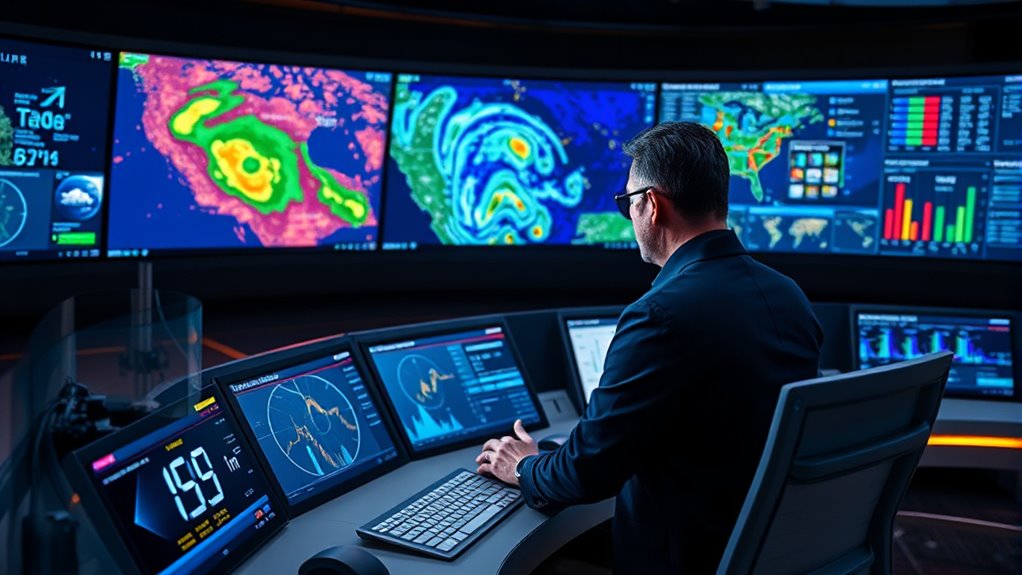To get advanced weather and seeing forecasts within 15 minutes, leverage modern tools like Windy, AccuWeather, Dark Sky, and Ventusky, which use high-resolution models, satellite data, and AI for quick, precise updates. Develop quick routines to check these platforms regularly, set alerts, and interpret key factors like cloud cover and turbulence to make informed decisions. Keep exploring—there’s more to learn about maximizing these fast, accurate forecasts for your observation planning.
Key Takeaways
- Utilize high-resolution numerical models and satellite data for rapid, localized weather predictions within 15 minutes.
- Leverage AI-powered forecasting tools like Windy or Ventusky for instant, detailed weather and seeing condition updates.
- Establish regular, quick check routines and set alerts to monitor atmospheric stability and turbulence forecasts proactively.
- Interpret key seeing indicators such as cloud cover and turbulence levels to make immediate observation decisions.
- Integrate forecast apps with scheduling tools for seamless, real-time adjustments based on current weather conditions.
The Evolution of Weather Forecasting for Astronomy

The way weather forecasting for astronomy has evolved reflects ongoing technological advancements that improve precision and speed. Historically, forecast accuracy was limited, often providing broad predictions that didn’t meet astronomers’ needs. Over time, technological improvements have steadily enhanced forecast reliability, allowing for more accurate planning. Additionally, user interface design has become more intuitive, enabling astronomers to access and interpret data quickly. Modern tools present complex forecast data clearly, helping you make informed decisions with confidence. These developments have reduced uncertainty, making it easier to schedule observations during optimal conditions. As technology continues to advance, forecast accuracy will only improve, further supporting astronomers in maximizing their observation time and achieving better results. The incorporation of advanced sensors into weather models has also contributed significantly to these improvements.
Key Technologies Enabling Rapid Forecasts

You rely on high-resolution numerical models to generate detailed forecasts quickly. Satellite data integration provides real-time insights that improve accuracy, while machine learning enhancements speed up processing and reduce errors. Together, these technologies make rapid, reliable weather predictions possible within just 15 minutes. Additionally, leveraging advanced tuning techniques similar to those used in Honda vehicle upgrades can optimize predictive algorithms for even faster results.
High-Resolution Numerical Models
High-resolution numerical models have become essential for delivering rapid and accurate weather forecasts, as they can simulate atmospheric processes with remarkable detail. By increasing the spatial and temporal resolution, these models capture small-scale phenomena like local convection, terrain effects, and microclimates, which are critical for precise forecasts. This enhanced detail directly improves forecast accuracy, especially for short-term predictions like seeing conditions. With advanced computational power, you can run these models quickly, generating detailed forecasts in just minutes. Their ability to represent complex atmospheric interactions at fine scales makes them invaluable for real-time decision-making. Ultimately, high-resolution numerical models enable you to deliver highly localized, reliable forecasts swiftly, transforming how you anticipate and respond to weather conditions. Dog names can also inspire memorable and fitting titles for personalized weather alerts or forecasts.
Satellite Data Integration
By integrating satellite data with advanced processing techniques, you can access extensive, real-time atmospheric insights. Satellite imagery provides detailed visuals of cloud cover, storm development, and temperature patterns, while data fusion combines multiple data sources for a clearer picture. This integration allows you to rapidly analyze current conditions, identify emerging weather phenomena, and update forecasts within minutes. The key is to merge satellite imagery with ground-based observations and other sensor data, creating a unified, accurate dataset. With this approach, you eliminate gaps in information and reduce processing time. As a result, you can generate precise, up-to-the-minute forecasts that improve decision-making, especially when timely weather information is critical. Satellite data integration accelerates your ability to deliver fast, reliable weather insights, much like GMC tuning enhances vehicle performance through precise modifications.
Machine Learning Enhancements
Machine learning algorithms substantially enhance the speed and accuracy of weather forecasts by rapidly analyzing vast amounts of integrated data. Through sensor fusion, you combine data from satellites, ground stations, and IoT devices, creating a thorough view of atmospheric conditions. Deep learning models process this complex data efficiently, identifying patterns and making predictions in real-time. These models can recognize subtle changes in weather patterns that traditional methods might miss, enabling you to generate forecasts within minutes. By leveraging machine learning enhancements, you reduce processing time while improving forecast reliability. This combination of sensor fusion and deep learning accelerates the entire forecasting process, empowering you to deliver precise, up-to-the-minute weather predictions quickly and confidently.
How Data Integration Streamlines Planning

By integrating data from multiple sources, you get a clear, unified view of weather conditions and observations. This streamlines your planning process, allowing for quicker adjustments based on the latest information. With real-time decision-making, you can respond faster and improve overall efficiency. Incorporating advanced tuning techniques from the automotive world demonstrates how leveraging diverse data can optimize outcomes across various industries.
Unified Data Sources
When data sources are integrated into a unified system, planning becomes considerably more efficient. This process, known as source unification, consolidates diverse datasets into a single, accessible platform. Data harmonization guarantees that information from multiple sources aligns seamlessly, eliminating discrepancies and inconsistencies. By unifying data, you reduce the time spent cross-referencing different feeds, allowing for faster decision-making. It also improves accuracy, as all data points follow consistent formats and standards. With a centralized system, you gain a comprehensive view of weather conditions and seeing forecasts, enabling you to respond proactively. This streamlined approach minimizes errors and delays, so you can focus on optimizing your plans instead of managing fragmented information. Ultimately, source unification simplifies complex data landscapes, making your planning process more agile and reliable. Transparency about affiliate relationships can further enhance trust in your data sources and insights.
Real-Time Decision Making
Integrating data sources in real-time allows you to make swift, informed decisions as weather conditions evolve. When cloud cover shifts unexpectedly or temperature fluctuations occur, you can respond immediately, adjusting plans accordingly. Real-time data helps you track changing conditions precisely, reducing delays caused by outdated information. This streamlined approach enables you to anticipate issues before they arise, whether it’s safety concerns or logistical challenges. With instant access to live weather updates, you can adapt your strategies on the fly and optimize safety and efficiency. Accurate data ensures your decisions are based on the latest information, minimizing risks associated with environmental unpredictability. No more relying on delayed reports or guesswork—your decisions become more accurate and timely, ensuring you stay ahead of dynamic weather patterns and maintain smooth operations regardless of environmental changes.
Top Tools and Platforms for 15-Minute Weather Checks

Are you looking for quick, reliable ways to check the weather in just 15 minutes? Several tools and platforms can give you real-time updates on cloud cover, wind speed, and overall conditions. These options are perfect for planning outdoor activities or observing conditions for astronomy.
Need quick weather updates in 15 minutes? Use apps like Windy, AccuWeather, Dark Sky, or Ventusky for real-time conditions.
- Windy.com: Offers detailed maps showing wind speed, cloud cover, and weather patterns with quick updates.
- AccuWeather: Provides fast, hyper-local forecasts with radar and satellite imagery.
- Dark Sky: Offers concise, minute-by-minute weather updates, including cloud cover and wind speed.
- Ventusky: Visualizes weather data globally, highlighting cloud movements and wind patterns in seconds.
Additionally, emerging AI-powered tools are beginning to provide instant, highly accurate weather predictions based on complex data analysis, making advanced weather forecasting more accessible than ever.
These platforms help you stay ahead, ensuring you’re prepared for any weather shift within 15 minutes.
Interpreting Seeing Conditions for Optimal Observation

Understanding seeing conditions is essential for maximizing your observation quality, as atmospheric stability directly affects image clarity. Seeing variability can cause fluctuations in image sharpness and detail, making it crucial to interpret forecasts accurately. Pay attention to forecast accuracy; reliable predictions help you decide when conditions are optimal. Look for indicators like stable atmospheric layers and low turbulence, which suggest better seeing. If the forecast predicts poor seeing, consider adjusting your schedule or targeting brighter objects less affected by atmospheric distortion. Conversely, when seeing is forecasted to improve, prepare to optimize your observation session. Remember, even with precise forecasts, real-time assessment through your own experience remains vital. Combining forecast interpretation with on-the-spot judgment ensures you make the most of each viewing opportunity. Additionally, understanding weather patterns can help you anticipate changes that might influence seeing conditions during your session.
Practical Tips for Incorporating Rapid Forecasts Into Your Routine

To make the most of rapid weather and seeing forecasts, start by establishing a quick routine that fits into your planning process. Use predictive analytics tools with intuitive user interfaces to access forecasts swiftly. Incorporate these tips to streamline your approach:
Establish a quick routine with intuitive tools to access rapid weather and seeing forecasts efficiently.
- Check forecast updates first thing in your planning session
- Use customizable dashboards for quick data access
- Set alerts for significant changes in weather or seeing conditions
- Integrate forecast apps with your scheduling tools for seamless updates
- Cultivate an awareness of personal intuition to complement forecast data and enhance decision-making accuracy
Future Developments in Short-Interval Weather Modeling

Advancements in short-interval weather modeling are rapidly transforming how you access real-time forecasts. Soon, you’ll get even more precise updates on cloud coverage and wind variability, critical for planning activities. Future developments will leverage high-resolution data and machine learning algorithms to predict rapid changes in weather patterns within 15-minute windows. This means you’ll see detailed forecasts of cloud coverage shifts that could impact visibility or observing conditions, along with real-time wind variability insights that affect stability and safety. These innovations will refine forecasting accuracy, helping you make better decisions whether you’re outdoors, managing events, or operating sensitive equipment. As technology evolves, expect more intuitive interfaces and seamless integrations, making ultra-short-term weather data an indispensable part of your planning toolkit.
Frequently Asked Questions
How Accurate Are 15-Minute Weather Forecasts Compared to Longer-Term Predictions?
15-minute weather forecasts are quite reliable for short-term prediction accuracy, especially in localized areas. You can trust their forecast reliability because they use real-time data and advanced models to provide precise updates. While longer-term predictions have more uncertainty, these short-term forecasts give you quick, accurate insights into immediate weather changes, helping you plan your activities with confidence. Overall, their accuracy is high for immediate weather conditions.
Can Rapid Weather Forecasts Be Customized for Specific Astronomical Locations?
Yes, you can customize rapid weather forecasts for specific astronomical locations by leveraging satellite imagery and atmospheric modeling. These tools help you analyze localized conditions, predict cloud cover, and identify ideal viewing times. By integrating satellite data with detailed atmospheric models, you get precise, tailored forecasts that improve your observational planning. This customization guarantees you’re prepared for clear skies, maximizing your astronomical experience with accurate, location-specific weather insights.
What Are the Limitations of Current Rapid Weather Modeling Technologies?
You’ll find that current rapid weather modeling technologies face limitations due to data resolution and model latency. Low data resolution can reduce forecast accuracy, especially for localized conditions critical for astronomy. Additionally, model latency — the delay between data collection and forecast generation — prevents real-time updates, making it harder to predict sudden weather changes. These factors restrict the precision and timeliness of rapid weather forecasts, especially for specific astronomical locations.
How Do Quick Forecasts Account for Sudden Weather Changes During Observations?
When sudden weather changes occur, quick forecasts respond dynamically by analyzing real-time data, triggering precipitation alerts and updating cloud cover predictions instantly. You’ll see alerts pop up as models detect shifting patterns, giving you a heads-up before the weather turns. This rapid adaptation keeps your plans safe, letting you act swiftly. The suspense builds as the forecast continually refines itself, ensuring you stay ahead of unpredictable weather surprises.
Are There Any Subscription Services Offering Instant Weather Updates for Astronomers?
Yes, you can access subscription services that offer instant weather updates for astronomers. These services leverage satellite imagery and cloud tracking technology to provide real-time data, helping you stay ahead of sudden weather changes. With instant alerts, you can plan your observing sessions more effectively, avoiding clouds and bad weather. Popular options include specialized weather apps and services designed specifically for astronomers, ensuring you get timely, accurate forecasts.
Conclusion
Now, imagine having the power to make last-minute decisions with confidence, knowing exactly what the sky will reveal in just 15 minutes. As technology continues to advance, the line between uncertainty and precision blurs, opening new horizons for your astronomical pursuits. Will these quick forecasts become your secret weapon for perfect nights? Stay tuned, because the next breakthrough might just change how you plan your stargazing forever.








